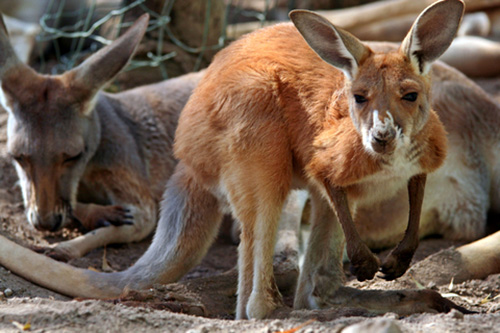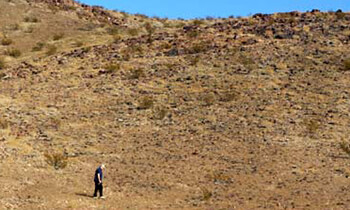Red Kangaroo
(Macropus rufus)
by Jay W. Sharp

Kangaroos have a multitude of nicknames. Often called "roos," they are called a "mob" when they're in a group. A lone male is a "jack" or a "buck," and an alpha male, a "boomer. " A female could be a "jill" or a "doe," and a young one is a "joey." The red kangaroo is the best known of the species, all four of which are native to Australia.
Characteristics of the Red Kangaroo
The red kangaroo is the largest of the four kangaroo species. It is also the largest of Australia's land animals, the largest of the world's hopping vertebrates, and the largest of the world's marsupials.
A marsupial, a taxonomic category within the class of mammalia, is born only partially developed. The newborn is minute, hairless, deaf and blind. Instinctively, within moments, it climbs up the mother's abdomen and into her belly pouch. Inside, it attaches itself by mouth to one of her mammary glands, where it will remain connected for months to nurse and complete its development.
- Size and Weight: Typically the powerfully built, mature, male red kangaroo stands five or six feet tall. Its heavy tail measures some three feet in length, serving almost like an extra leg for balance and stability. The animal may weigh 200 pounds. The female is roughly a third smaller than the male.
- Head: The roo has a relatively small head with a face, nose and ears somewhat like a mule deer. It has white stripes between the corners of its mouth and the bases of its ears. Its eyes, located near the sides of its face, give it a field of view of about 300 degrees. (By comparison, a human, with eyes located on the front of the face, has a field of view of roughly 180 degrees.) The roo's teeth include incisors for cropping grass and molars for grinding. New teeth regularly move forward to replace those that wear down and fall out.
- Body: The body has a chambered stomach, much like a cow. In one of its most distinctive characteristics, the female has a pouch with four mammary glands inside. It is her nursery, where she raises, nurtures and protects her young.
- Forelegs: The red kangaroo has foreshortened forelegs with heavily clawed paws that serve for eating, grooming and fighting (or "boxing").
- Hindlegs: It has long hindlegs with brawny hindquarters that have strong, elastic-like tendons, which power the animal's hops. It has large back feet, each with second and third toes fused into a single large claw that is used in grooming and fighting. The kangaroo can't move its back legs independently, so it can travel only by hopping. Propelled by its hindlegs, the red kangaroo can reach speeds of about 35 to 40 miles an hour and can clear 25 feet in a single leap.
- Coat and Color: The red kangaroo has a thick wool-like coat that is usually reddish for the male and bluish gray for the female, with the underparts and legs lighter in color for both sexes. The animal's colors and shades vary with locale.
- Senses: The kangaroo has keenly developed senses of smell, vision and hearing.
- Communication: The roo's methods for communication are little understood. It seems to stamp its feet and thump its tail to alert its mob to impending danger. It also appears to leave chemical traces that may be signals to other roos.
Distribution, Habitat and Diet
The red kangaroo is common in inland Australia, and prefers open grasslands though it is found in scrub and desert areas as well. Herbivorous, the animal looks for green, new-growth grasses to eat, which usually comprise the great majority of its diet. It uses its forepaws to push older, dried plants aside to reach the new growth. It also eats mature grasses and broadleaf plants. It may venture some miles from its home range to reach the new growth that follows recent rains. The red kangaroo will drink water if it is readily available, but, physiologically, it is well adapted to an arid environment. It can meet most of its moisture needs from the water stored in the tissues of plants it consumes.
Behavior and Life Cycle
In areas with sizable populations, a single red kangaroo typically belongs to a mob made up of a boomer, several jills, several joeys and a few juvenile animals. It forages primarily in the late afternoon and evening and in the pre-dawn and dawn. On hot sunny days, it takes shelter in the shade of scattered shrubs and trees, sweating and panting while it licks its forelimbs.
Young males, seeking dominance, may engage in "boxing" contests. They lock forearms, wrestle and kick, using their tails for additional support and leverage. A consistent winner may achieve "boomer" status and win mating rights.
Because of its large size and power, the red kangaroo suffers relatively little from predation, although the younger animals are sometimes attacked by dingoes (Australia's wild dogs), large predatory birds or reptiles. If attacked, the roo uses its forelegs and paws to seize its enemy, delivering powerful kicks with its hind legs. It may use the specially adapted claws on its back feet to disembowel an adversary. Competent as a swimmer, the animal may plunge into nearby water to escape a predator. If followed, the roo may use its forelegs to seize the attacker and hold it underwater until it drowns.
Unlike many large mammals, the red kangaroo mates all year, with the coupling lasting perhaps half an hour. Little more than a month after mating, the mother delivers her underdeveloped newborn, which measures maybe an inch in length. With it safely ensconced in her pouch and attached to a teat, she may conceive again, almost immediately, although the new, unborn fetus will remain in a suspended state, called "embryonic diapause," for several months, while its predecessor develops and grows, emerging from the mother's pouch tentatively at first, then permanently after about eight months. The newly emerged joey continues to suckle for several more months. Meanwhile, the new fetus resumes its development and prepares to follow the course of its sibling. After the fetus is born, the mother may mate yet again. At one time, she may have a juvenile joey that returns intermittently and nurses within her pouch, a second that clings continuously to a teat within her pouch, and a third that awaits in embryonic diapause within her uterus. Rarely, to complicate matters, she may bear twins.
A young male joey reaches sexual maturity at about two to three years, and a young female, at roughly a year and a half to two years. If it reaches maturity, a red kangaroo may live for up to 23 years.
Perils
The red kangaroo remains abundant in Australia, numbering in the millions, although the population may be affected locally and intermittently by factors such as predation, disease, land use, prolonged drought, inadequate forage, accidents (e.g., collisions with automobiles) and commercial harvesting. The International Union for Conservation of Nature and Natural Resources (IUCN) considers the red kangaroo to be a species of "least concern."
Interesting Facts
- According to various sources, the early Europeans in Australia described the kangaroo as an animal that had a head like a deer with no antlers. It stood upright like man. It hopped like a frog. Some, seeing a young joey peering from its mother's pouch, thought that the kangaroo must have two heads, one on its shoulders and another on its belly.
- In spite of protests by animal rights groups, commercial hunters kill more than a million roos annually for meat and leather, fueling a multimillion dollar industry. In one evening in the spring of 2002, for example, a commercial hunter "shot 28 kangaroos and a wild boar, netting himself more than $300," said Shawn Donnan, writing for the Christian Science Monitor.
- As a national symbol, the kangaroo appears on the Australian coat of arms, the Australian currency, and on Australian commercial organizations' emblems.
References:
University of Michigan Museum of Zoology
National Geographic
Share this page on Facebook:
The Desert Environment
The North American Deserts
Desert Geological Terms







